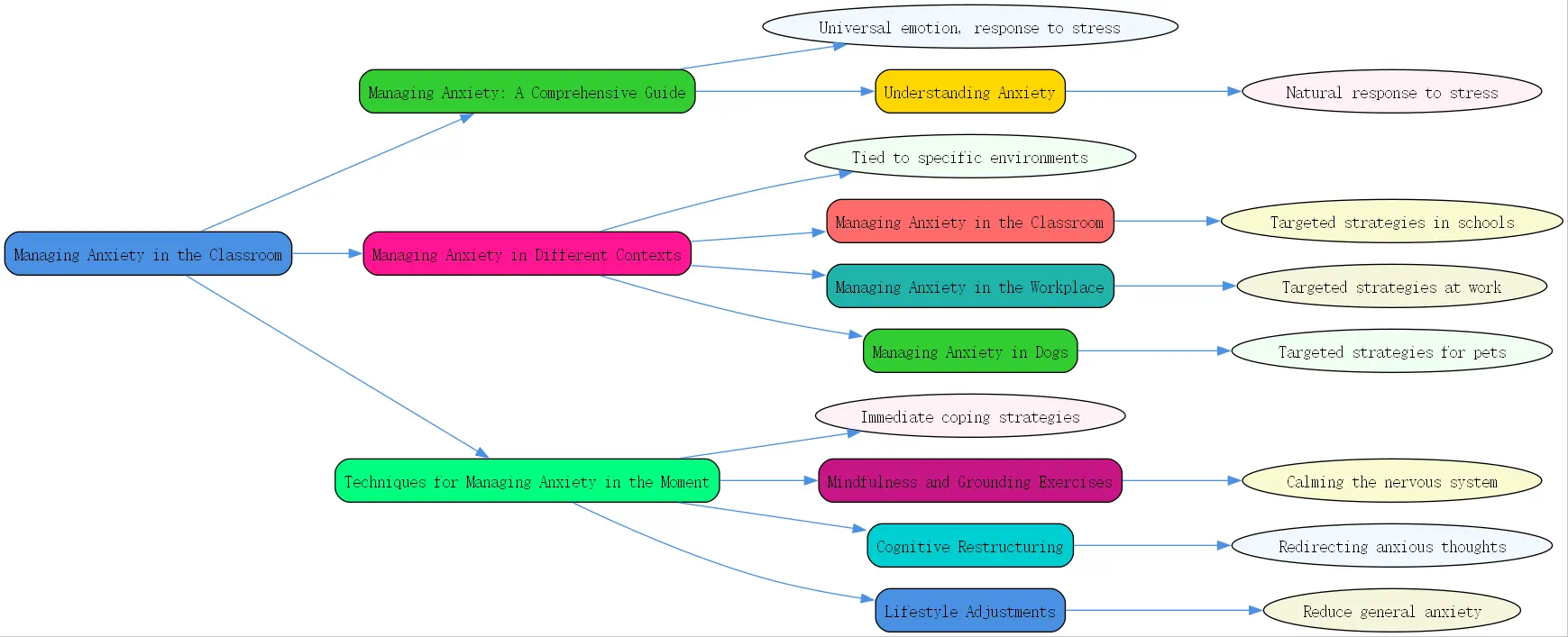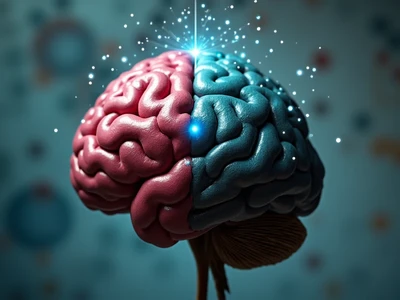Managing Anxiety: A Comprehensive Guide

Anxiety is a universal human emotion, a natural response to stress or perceived threats. While occasional anxiety is normal, persistent or overwhelming feelings can significantly impact daily life, affecting performance, relationships, and overall well-being. Understanding and managing anxiety is crucial not just for humans in various settings like schools and workplaces, but also for our beloved animal companions. This guide explores the multifaceted nature of anxiety and provides practical strategies for coping effectively across different contexts.
Understanding Anxiety
Anxiety manifests differently in everyone, but it generally involves feelings of unease, worry, or fear, ranging from mild nervousness to intense panic. It’s the body’s internal alarm system, preparing us to face challenges. However, when this system becomes overly sensitive or is triggered inappropriately, it can lead to an anxiety disorder, impacting millions worldwide.
Defining Anxiety: In Humans and Animals
In humans, anxiety often presents as excessive worry, restlessness, irritability, difficulty concentrating, and physical symptoms like a racing heart, sweating, or trembling. For animals, particularly dogs as highlighted in studies on separation anxiety, it can manifest through behavioral changes such as excessive barking, destructive actions, inappropriate elimination, or visible distress like panting and pacing when separated from their primary caregivers. Recognizing these signs is the first step toward providing support.
The Role of Anxiety in Daily Life
A certain level of anxiety can be motivating. It can sharpen focus before an exam, fuel performance during a presentation, or heighten awareness in potentially dangerous situations. This is often referred to as adaptive anxiety. Problems arise when anxiety becomes chronic, excessive, and debilitating, interfering with routine activities, work, school, and social interactions. Understanding this distinction helps in identifying when intervention is necessary for better mental health management.
Managing Anxiety in Different Contexts

Anxiety doesn’t operate in a vacuum; it’s often tied to specific environments or situations. Recognizing context-specific triggers and implementing targeted strategies is key to effective management, whether in educational settings, professional environments, or even in caring for our pets. Each context presents unique challenges and requires tailored approaches.
Managing Anxiety in the Classroom
Schools can be significant sources of stress for students, stemming from academic pressure, social interactions, or performance expectations. Effectively managing anxiety in the classroom involves creating an environment where students feel safe, understood, and equipped with coping tools. Educators play a vital role in identifying struggling students and fostering resilience.
Identifying Sources of Anxiety in Students
Student anxiety can arise from various sources. Fear of failure, test anxiety, social pressures like bullying or fitting in, difficulties with specific subjects, and even issues originating outside of school can contribute. Observing changes in behavior, such as withdrawal, irritability, difficulty concentrating, or physical complaints, can indicate underlying anxiety that needs attention. Open communication between teachers, students, and parents is essential.
Creating a Supportive Classroom Environment
A supportive classroom minimizes anxiety triggers. This includes establishing clear routines, setting realistic expectations, encouraging effort over perfection, and promoting a culture of kindness and respect. Teachers can incorporate mindfulness moments, allow breaks, and provide flexible options for participation and assessment, making the learning space feel less threatening and more inclusive for everyone.
Practical Techniques for Reducing Student Anxiety
Teachers can equip students with practical tools. Teaching simple deep-breathing exercises or grounding techniques can help students manage anxiety surges. Breaking down large assignments into smaller steps makes tasks less daunting. Encouraging positive self-talk and providing opportunities for non-competitive group activities can also build confidence and reduce performance anxiety, contributing to better overall managing anxiety in the classroom.
Managing Anxiety in the Workplace
The modern workplace, with its deadlines, demands, and interpersonal dynamics, can be a breeding ground for anxiety. Addressing this requires both individual coping strategies and organizational efforts to foster a mentally healthy environment. Recognizing the signs and sources is the first step towards effective `managing anxiety in the workplace`.
Recognizing Anxiety Triggers at Work
Common workplace anxiety triggers include heavy workloads, tight deadlines, lack of control over tasks, difficult relationships with colleagues or superiors, fear of job insecurity, and poor work-life balance. Performance reviews or public speaking can also provoke significant stress. Identifying personal triggers helps in developing proactive coping mechanisms.
Strategies for Reducing Workplace Stress
Individuals can manage workplace anxiety by setting realistic goals, prioritizing tasks, taking regular breaks, and practicing time management techniques. Establishing clear boundaries between work and personal life is crucial. Mindfulness, meditation, and physical activity outside of work hours can also significantly buffer against stress and improve resilience during demanding periods.
Promoting Mental Well-being Among Employees
Organizations have a responsibility to promote mental health. This can involve offering flexible work arrangements, providing access to mental health resources like Employee Assistance Programs (EAPs), training managers to recognize and support struggling employees, and fostering a culture where discussing mental health is destigmatized. Encouraging regular check-ins and open communication channels contributes significantly to a healthier work environment.
Managing Anxiety in Dogs
Anxiety isn’t exclusive to humans; our canine companions can experience it too, most notably as separation anxiety. Understanding the roots and signs of distress is crucial for `managing anxiety in dogs` effectively, ensuring their well-being and preserving the human-animal bond. This often requires patience and consistent effort from owners.
Understanding Separation Anxiety in Dogs
Separation anxiety occurs when dogs become highly distressed due to being left alone or separated from their primary attachment figure. This isn’t simple misbehavior; it’s a panic response rooted in fear and insecurity. Dogs are social pack animals, and the absence of their “”pack leader”” (the owner) can trigger profound anxiety in susceptible individuals.
Causes and Symptoms of Anxiety in Dogs
Several factors can contribute, as detailed in the reference text. Early life experiences like abandonment or trauma, sudden lifestyle changes (new home, new schedule), lack of proper socialization, or even breed predisposition can play a role. Symptoms are varied: excessive barking/howling, destructive chewing or digging (often near exits), inappropriate urination/defecation despite being house-trained, frantic pacing, excessive drooling or panting, trembling, and even attempts to escape confinement which can lead to injury. Exaggerated greetings upon the owner’s return are also common.
Effective Techniques for Managing Dog Anxiety
Managing this condition involves behavior modification techniques aimed at changing the dog’s emotional response to being alone. Gradual desensitization is key: start with very short absences (minutes) and slowly increase the duration as the dog remains calm. Create a comfortable, safe space (like a crate, if crate-trained positively) with familiar items. Practice “”departure cues”” (like picking up keys) without actually leaving to reduce their predictive power. Use positive reinforcement, rewarding calm behavior during departures and arrivals. Counter-conditioning helps create positive associations with being alone ??offer high-value treats or puzzle toys only when you leave. Vary departure routines to prevent anticipation anxiety. In severe cases, veterinary consultation for anti-anxiety medication, combined with guidance from a professional dog trainer or veterinary behaviorist, may be necessary. Options like doggy daycare or pet sitters can provide companionship for dogs who struggle significantly when left alone, reducing their distress. Building trust and consistent training are foundational.
Techniques for Managing Anxiety in the Moment
When anxiety strikes unexpectedly, having immediate coping strategies can make a significant difference. These techniques focus on calming the nervous system and redirecting anxious thoughts, providing relief when it’s needed most. Effective `managing anxiety in the moment` empowers individuals to regain control.
Mindfulness and Grounding Exercises
Mindfulness brings awareness to the present moment without judgment, while grounding anchors you to the physical world, pulling focus away from overwhelming thoughts or feelings. These practices are simple yet powerful tools for immediate anxiety relief and can be done almost anywhere.

Deep Breathing Techniques
Slow, deep breaths signal the brain to calm down, counteracting the rapid, shallow breathing common during anxiety. Try the 4-7-8 technique: inhale quietly through your nose for 4 seconds, hold your breath for 7 seconds, and exhale completely through your mouth for 8 seconds. Repeat several times until you feel more centered.

The 5-4-3-2-1 Grounding Method
This technique engages your senses to reconnect with your surroundings. Identify: 5 things you can see, 4 things you can touch, 3 things you can hear, 2 things you can smell, and 1 thing you can taste. This sensory focus interrupts the cycle of anxious thoughts, grounding you firmly in the present reality.
Body Scan Meditation
A body scan involves bringing gentle, non-judgmental awareness to different parts of your body, noticing any sensations like tension or warmth. Start from your toes and slowly move up to the top of your head. This practice enhances body awareness and can release physical tension often associated with anxiety. [Link to BrainTalking article on mindfulness] could offer further guidance.
Cognitive Restructuring
Anxiety often fuels, and is fueled by, negative or distorted thought patterns. Cognitive restructuring involves identifying these patterns and actively working to change them into more realistic and positive ones. This is a core component of Cognitive Behavioral Therapy (CBT).
Identifying Negative Thought Patterns
Common anxious thought patterns include catastrophizing (expecting the worst), personalization (blaming oneself for external events), black-and-white thinking (seeing things as all good or all bad), and overgeneralization (drawing broad conclusions from single events). Recognizing these patterns is the first step to challenging their validity.
Challenging Anxious Thoughts
Once an anxious thought is identified, question its accuracy. Ask yourself: What is the evidence for this thought? Is there another way to look at this situation? What is the worst that could happen, and could I cope? This critical examination helps diminish the thought’s power. Consulting resources like the Anxiety & Depression Association of America [Link to ADAA website] can provide further strategies.
Replacing Negative Thoughts with Positive Affirmations
Actively replace challenged negative thoughts with more balanced, realistic, or positive affirmations. Instead of “”I’m going to fail this presentation,”” try “”I’ve prepared well, and I’ll do my best.”” Consistent practice helps rewire thought patterns over time, reducing the default tendency towards anxious thinking.
Lifestyle Adjustments
Long-term anxiety management often benefits significantly from sustainable lifestyle changes that support overall physical and mental health. These adjustments build resilience and reduce vulnerability to anxiety triggers. Making gradual changes is often more effective than attempting drastic overhauls.
The Importance of Regular Exercise
Physical activity is a potent anxiety reliever. Exercise releases endorphins, natural mood boosters, and helps reduce muscle tension. Aim for regular moderate activity, like brisk walking, jogging, swimming, or yoga. Even short bursts of movement throughout the day can make a difference in managing stress levels.
The Role of Diet in Managing Anxiety
What you eat can influence your mood and anxiety levels. A balanced diet rich in fruits, vegetables, whole grains, and lean proteins supports brain health. Conversely, excessive caffeine, sugar, and processed foods can exacerbate anxiety symptoms in some individuals. Staying hydrated is also crucial for optimal brain function.
Ensuring Adequate Sleep
Poor sleep and anxiety often form a vicious cycle. Lack of sleep can increase anxiety, while anxiety can make falling or staying asleep difficult. Prioritize good sleep hygiene: maintain a consistent sleep schedule, create a relaxing bedtime routine, and ensure your bedroom is dark, quiet, and cool. Aim for 7-9 hours of quality sleep per night. As BrainTalking often emphasizes, foundational health habits are key to mental well-being.
Key Takeaways for Managing Anxiety:
- Acknowledge Anxiety: Recognize that anxiety is a common experience in humans and animals, but chronic anxiety requires management.
- Context Matters: Tailor strategies for specific environments like classrooms, workplaces, or for pets experiencing separation distress.
- Utilize In-the-Moment Techniques: Employ mindfulness, grounding, and deep breathing for immediate relief.
- Challenge Thoughts: Practice cognitive restructuring to counteract negative thought patterns.
- Adopt Healthy Habits: Prioritize exercise, balanced nutrition, and adequate sleep for long-term resilience.
- Seek Support: Don’t hesitate to consult professionals (therapists, veterinarians, behaviorists) when needed. Patience and consistency are vital.
Q&A: SEO and Mental Health Content
Q: How does writing about sensitive topics like anxiety impact SEO and E-E-A-T signals for a site like BrainTalking?
A: Writing about mental health topics like anxiety falls under Google’s “”Your Money or Your Life”” (YMYL) category. This means content must meet extremely high standards for Expertise, Authoritativeness, and Trustworthiness (part of E-E-A-T, with Experience being the added element).
- Expertise & Experience: Content should be written or reviewed by qualified mental health professionals or demonstrate deep, experience-based knowledge. Citing credible sources (academic studies, established health organizations like the [Link to NIMH website]) is crucial. Sharing personal experiences, when relevant and framed responsibly, can demonstrate the ‘Experience’ aspect.
- Authoritativeness: The website itself (like BrainTalking, positioned as a psychology expertor) needs to establish authority in the mental health space. This involves consistent, high-quality content, positive user reviews, and potentially recognition from other authoritative sources. Author bios showcasing credentials are very important.
- Trustworthiness: Transparency is key. Clearly state the purpose of the content (informational, not a substitute for professional diagnosis/treatment). Ensure factual accuracy and provide balanced perspectives. Secure website hosting (HTTPS) and clear contact information also contribute to trust.




